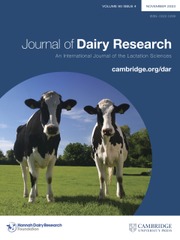No CrossRef data available.
Article contents
Compositional and microbial transitions from colostrum to transition milk in Guanzhong dairy goats
Published online by Cambridge University Press: 15 October 2025
Abstract
Colostrum (CM) and transition milk (TM) are crucial for neonatal development but knowledge about the changes in their composition in dairy goats is still limited. The aim of this study was to characterise the immunological, lipid and microbial changes from CM to TM in Guanzhong dairy goats, an indigenous, highly productive Chinese breed. Milk samples were collected from eight primiparous goats at day 0 (CM) and day 7 (TM) postpartum. Immunoglobulin concentrations (IgG, IgA, IgM) were measured by ELISA, long-chain saturated fatty acids (FA) were analysed by gas chromatography, and bacterial communities were profiled by 16S rRNA gene amplicon sequencing. Microbial functions were inferred using PICRUSt2 (Phylogenetic Investigation of Communities by Reconstruction of Unobserved States) software based on KEGG (Kyoto Encyclopedia of Genes and Genomes) orthologs. Immunoglobulin concentrations declined significantly from CM to TM, reflecting a transition from immunoprotection to food supply. The TM had increased concentrations of long-chain saturated FA, particularly palmitic acid (C16:0) and stearic acid (C18:0) and higher concentrations of branched-chain FA, suggesting an adaptation to the growing energy demands of the newborn. Although overall microbial diversity was stable, taxonomic shifts were observed. CM was enriched in Emticicia, which may be involved in oligosaccharide degradation, while TM had higher abundance of Faecalibacterium, Ruminococcus and Salinicoccus, genera associated with SCFA production and intestinal development. Functional predictions indicated enrichment of cold shock and haem biosynthetic pathways in CM and enhanced carbohydrate degradation pathways in TM. Correlation analyses revealed relationships between specific FA and bacterial genera, suggesting interactions between host, microbes and nutrients that may influence milk functionality. This integrative analysis of milk components during early lactation provides new insights into the compositional and functional dynamics of goat milk.
Information
- Type
- Research Article
- Information
- Copyright
- © The Author(s), 2025. Published by Cambridge University Press on behalf of Hannah Dairy Research Foundation.

